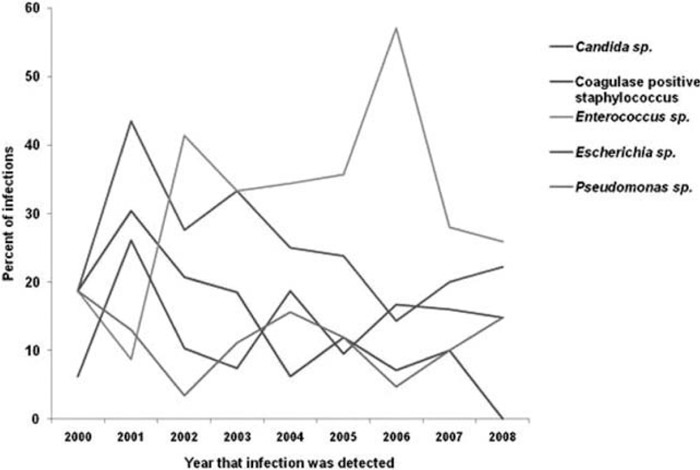Background:
Urinary tract infection (UTI) is the most frequent hospital‐acquired infection in the United States. Bloodstream infection (BSI) secondary to UTI occurs less frequently but is associated with significant morbidity and mortality. Despite renewed interest in hospital‐acquired UTI, little is known about the epidemiology of nosocomial urinary tract–related BSI.
Methods:
We reviewed patients using administrative electronic records coupled with manual chart review in a Midwestern academic medical center with more than 800 beds (99 of them intensive care units). The case definition was any hospitalized adult patient with a positive urine culture obtained >48 hours after admission and a blood culture obtained within 14 days of the urine culture that grew the same organism. A urine culture was defined as positive if it grew >103 CFU/mL of a single organism. Chi‐square analyses and t tests were used to assess unadjusted bivariate comparisons, and all analyses were performed using Stata/SE 11.0
Results:
During the study period, 350 patients met the case definition, with mean age of 58 years (range, 21–92 years), and 192 were male (54.9%). A majority of cases were admitted through the emergency department, 136 (38.9%), or from home, 83 (23.7%). Comorbid conditions included: renal disease, 176 (50.3%); heart disease, 170 (48.6%); malignancy, 139 (39.7%); diabetes, 86 (24.6%); neutropenia, 72 (20.6%); and transplant, 67 (19.1%). Predominant organisms included: Enterococcus sp., 97 (27.7%); Candida sp., 70 (20%); Escherichia coli, 41 (11.7%); coagulase‐positive Staphylococcus, 36 (10.3%); and Pseudomonas sp., 31 (9%); see Figure 1. Enterococcus sp. were more frequent among cases with histories of malignancy (P = 0.021), neutropenia (P < 0.001), transplant (P = 0.01), immuno‐suppressant therapy (P = 0.008), antiviral therapy (P < 0.001), and antifungal therapy (P < 0.001). Candida sp. were more frequent among cases with histories of liver disease (P = 0.003), renal disease (P = 0.002), transplant (P = 0.03), and previous antibacterial use (P < 0.001).
FIGURE 1. Temporal trends of nosocomial urinary tract–related bloodstream infection from 350 cases, 2000–2008.
Conclusions:
Enterococcus sp. and Candida sp. were the most frequent pathogens isolated from the bloodstream in patients with hospital‐acquired bacteriuria. Enterococcus sp. infections were associated with malignancy, neutropenia, and transplantation. Candida sp. infections were associated with renal disease and liver disease. The potential influence of Enterococcus sp. and Candida sp. should be considered in the context of patient comorbidities for appropriate presumptive antimicrobial therapy for nosocomial urinary tract–related bloodstream infection.
Disclosures:
S. Saint ‐ none; L. Kuhn ‐ none; E. Shuman ‐ none; C. Chenoweth ‐ none; T. Greene ‐ none; R. Chang ‐ none

